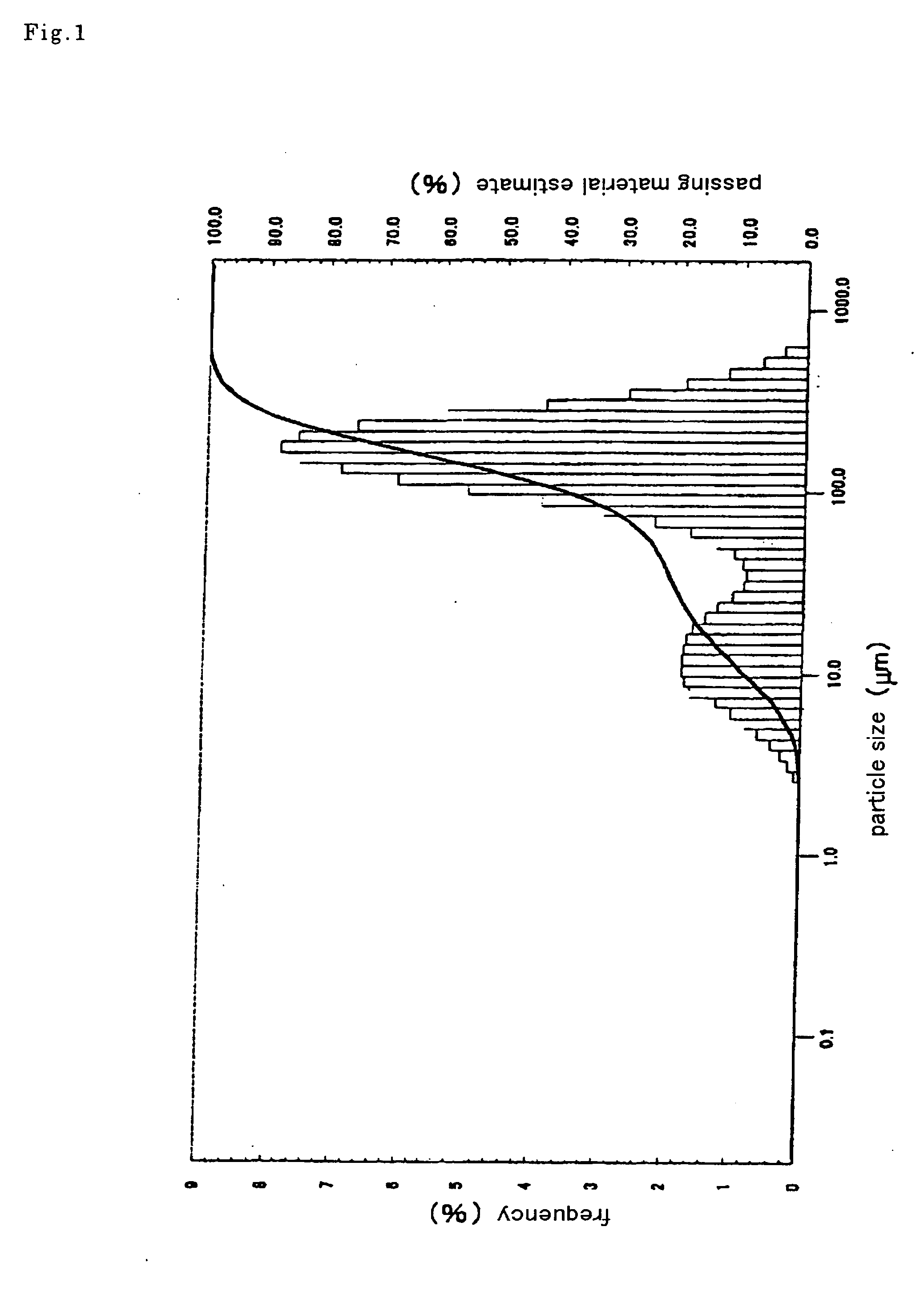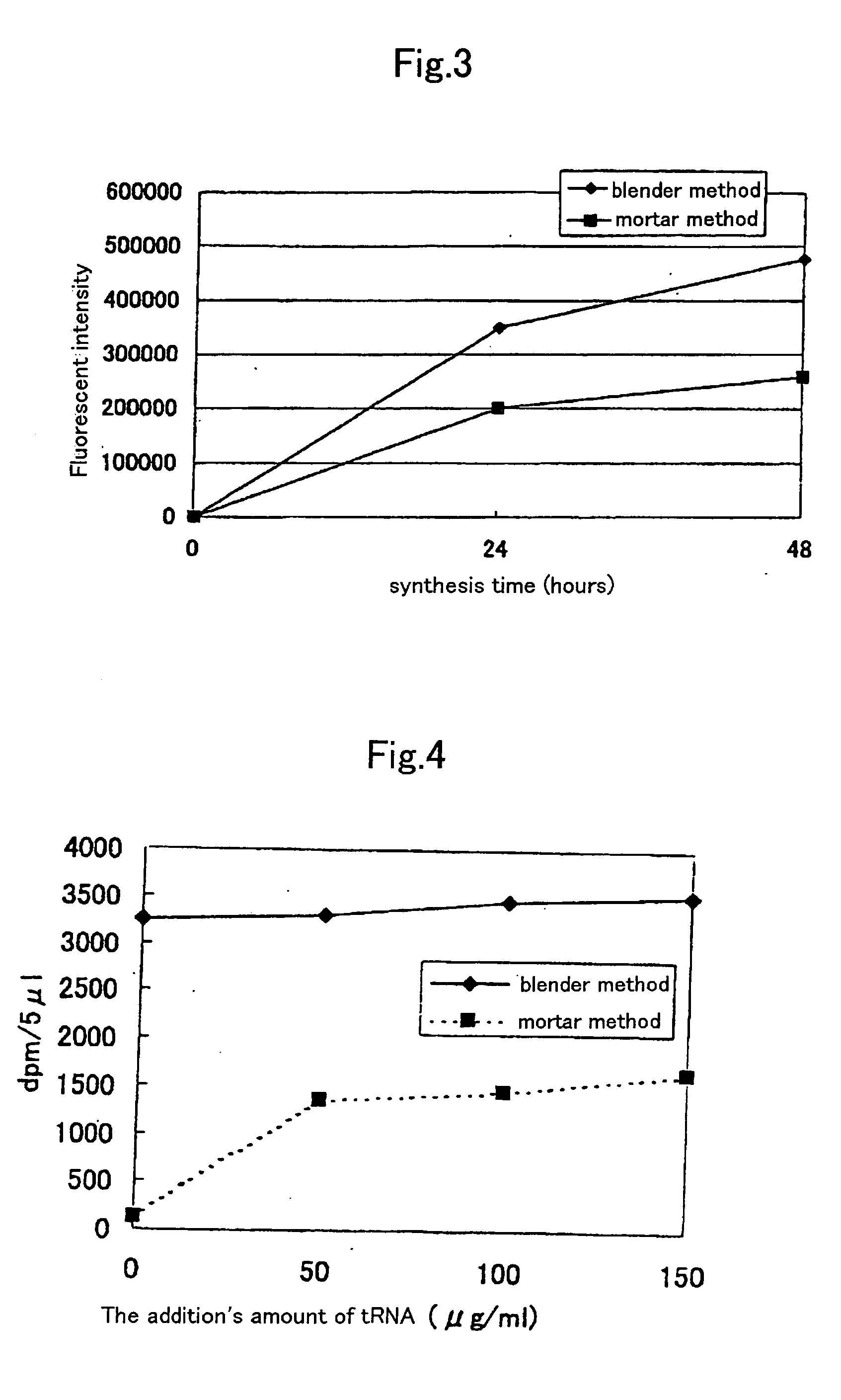Germ extract for cell-free protein synthesis and process for producing the same
- Summary
- Abstract
- Description
- Claims
- Application Information
AI Technical Summary
Benefits of technology
Problems solved by technology
Method used
Image
Examples
example 1
Pulverization and Extraction Using a Waring Blender (1)
Hokkaido Chihoku wheat (undisinfected) was added to a mill (Pulverisette 14 Rotor Speed Mill, Fritsch) at a rate of 100 g per minute, and the grains were moderately ground at 7000 rpm. This grinding process was repeated four times. After recovering a fraction containing germinatable embryos with a sieve (mesh size 0.71 to 1.00 mm), the surfacing fraction containing the germinatable embryos was recovered by heavy medium separation using a mixture of carbon tetrachloride and cyclohexane (volume ratio=carbon tetrachloride:cyclohexane=2.4:1), the organic solvent was eliminated by desiccation at room temperature, and then impurities such as seed coat were eliminated by air-blowing at room temperature to obtain a crude embryo fraction.
Next, a belt type color sorter BLM-300K (Manufacturer: Anzai Manufacturing Co., Ltd., Marketed by: Anzai Co., Ltd.) was used to select the embryo from the crude embryo fraction by way of color differ...
example 2
Preparation of a Wheat Embryo Cell-Free Protein Synthesis System Using Dialysis
The concentration of the solution containing wheat embryo extraction product produced in Example 1 was adjusted with extracting solvent so that the optical density at 260 nm (O.D.) (A260) was 90 and green fluorescent protein (GFP) was synthesized according to the method described in Endo, Y. et al., PNAS, Jan. 18, 2000, Vol. 97, No. 2, 559-564. The GFP activity was quantified by measuring the 510 nm fluorescent intensity at an excitation wavelength of 490 nm using a TD-360 Mini-Fluorometer by Turner Designs. As shown in FIG. 3 (indicated as blender method in FIG. 3) the fluorescent intensity was measured to be approximately 350,000 after 24 hours and 480,000 after 48 hours, confirming that GFP was being synthesized.
example 3
Analysis of Solution Containing Wheat Embryo Extraction Product (1)
Hokkaido Chihoku wheat (undisinfected) was used to prepare a solution containing wheat embryo extraction product by the same method as in Example 1. The concentration of the samples were adjusted with extracting solvent so that the optical density at 260 nm (O.D.) (A260) was 90, and the content of DNA and RNA in each of the samples was measured. The results are shown below.
RNA (μg / ml)DNA (μg / ml)Sample a11411141Sample a21554142
The methods for measuring the DNA and RNA content are as follows.
Method for Measuring DNA Content
DNA content was measured using a microplate fluorophotometer (SPECTRAmax GEMINI XS, Molecular Devices) using PicoGreen dsDNA quantitation reagent (Molecular Probes), with Calf Thymus DNA Standard (Pharmacia Biotech) as a standard sample.
First, 10 μl of proteinase K (10 mg / ml) were added to 200 μl of sample and this was reacted overnight at 55° C. After extracting the reaction solution with...
PUM
| Property | Measurement | Unit |
|---|---|---|
| Fraction | aaaaa | aaaaa |
| Density | aaaaa | aaaaa |
| Density | aaaaa | aaaaa |
Abstract
Description
Claims
Application Information
 Login to View More
Login to View More - R&D
- Intellectual Property
- Life Sciences
- Materials
- Tech Scout
- Unparalleled Data Quality
- Higher Quality Content
- 60% Fewer Hallucinations
Browse by: Latest US Patents, China's latest patents, Technical Efficacy Thesaurus, Application Domain, Technology Topic, Popular Technical Reports.
© 2025 PatSnap. All rights reserved.Legal|Privacy policy|Modern Slavery Act Transparency Statement|Sitemap|About US| Contact US: help@patsnap.com



